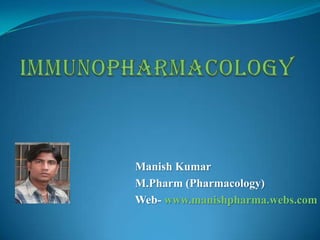
Immunopharmacology
- 1. Manish Kumar M.Pharm (Pharmacology) Web- www.manishpharma.webs.com
- 2. INTRODUCTION Immunopharmacology is the study of the effects of the drugs modifying immune mechanism in body. It includes not only inoculation but also autoimmune disorders, allergic reactions, and cancer. A significant development has new approach to control the immunological mechanism by drugs. Eg. Immunosuppressant.
- 3. THE IMMUNO SYSTEM IMMUNITY : It is the ability of the living body or the process to resist various types of organisms or toxins that tend to damage the tissue and organs.
- 4. CELLS INVOLVED IN IMMUNOSYSTEM Lymphocytes Neutrophils Basophils Eosinophils Monocytes Plasma cells Kupffer cells
- 5. Components of immune system Antigens A substance that when introduced into the body, stimulates the production of an antibody. An antigen is an organic compound - protein, polysaccharide or glycolipid. It has 2 parts o Hapten o Carrier Antigens include: Toxins Bacteria Foreign blood cells Microorganisms Allergens Viruses Etc.
- 6. Antibodies They are gamma globulins or immunoglobulin's produced in the serum on exposure to antigen. Chemically they are glycoprotein's containing two heavy chains and two light chains joined together by disulfide bonds. It has 2 parts 1) Fab 2) Fc The entire antibody structure can be cleaved by papain(a proteolytic enzyme)
- 8. TYPES OF ANTIBODIES There are 5 types : 1.IgG 2.IgM 3.IgA 4.IgE 5.IgD
- 9. CHARACTERISTICS OF ANTIBODIES TYPES MOL. WT. CONC. IN SERUM SPECIAL (mg/ml) CHARACTERSTICS Ig G 150,000 1200 Can produce anaphylaxis Ig M 900,000 100 Seen in vascular system most effective as agglutinin Ig A 160,000 400 Found in serum, saliva, tears, G.I Secretions Ig E 200,000 <0.01 Causes release of histamine from mast cells Ig D 185,000 NOT CLEAR Present on surphase
- 10. Immunopharmacology Mainly include : 1.Autoimmune disorders. 2.Allergy
- 11. AUTO-IMMUNE DISORDERS It is occur due to the immunity can not distinguish body own cells and organism cells and by mistake kill the body own cells. MECHANISAM: In auto immunity ,by activation of self reactive T& B lymphocytes that produce cell-mediated response directly against self-antigen and it may lead to killing of body own cells Eg. Rheumatoid arthritis Myasthenia gravis Ulcerative anemia etc.
- 12. The development of autoimmune disease depends on a combination of genetic and environmental factors like hormones, diet, toxins, drugs and infections. Genetic predisposition accounts for only about one-third of the risk of developing an autoimmune disease. while non- inherited environmental factors account for the remaining 70% risk. Environmental Gene Auto factors (70%) immune (30%) disease
- 13. Allergy Definition: Allergy is one of the consequences of immunological response involving antigen-antibody reaction and in it mainly increased reactivity to foreign material above normal. Hence it is also called hypersensitivity.
- 14. Types of allergy It has mainly 2 types: 1.Humoral a)type I or anaphylaxis b)type II or cytotoxic type c)Type III or toxic complex reaction 2.cell mediated allergy 3.miscellaneous types( atopy )
- 15. Humoral allergy In the humoral allergy the reaction of antigen occurs with humoral antibodies. 1. Type I (anaphylaxis) : It follows immediately after the administration of the drug. Eg. it occurs in the sensitized patient when given a penicillin inj. because the liberation of histamine leading to unwanted results. Gastrointestinal allergy are also comes under the immediate anaphylaxis type reaction
- 16. Treatment of anaphylaxis anti-histamines corticosteroid calcium(I.V)
- 17. 2. Type II (cytotoxic type): In this type, antigen is localized on the surface of target cell and the antibody present in the blood combines with antigen to cause the lysis of the target cell. Eg. Haemolytic anaemia Thrombocytopenia
- 18. 3. Type III (toxic complex reaction): This occurs due to the presence of elevated levels of antigen-antibody complexes that deposit on basement membrane in tissue and vessels and produce anaphylatoxic activities that increasing vascular permeability and recruit Neutrophils to site of complex deposition ,it may lead toxic reactions. Eg. Skin rashes Arthritis.
- 19. Cell mediated allergy In it, antigen reacts directly with lymphoid cells so it produce inflammatory response that cause cells damage and it is also characterized by the influx of antigen into the cells which activates macrophages and this macrophages are responsible for tissue damage. Eg. 1.bone-marrow lesions 2.lupus erythematous
- 20. Miscellaneous types (atopy) Atopic allergy may arise out of a single contact or ingestion of common articles of food or drugs in daily routine life. Eg. Fever Asthma Eeosinophilia
- 21. Therapy in Immunopharmacology: Immunosuppressant's Immunomodulators Immunoenhancers
- 22. Immunosuppressant's They are the agents that suppress the immune system. Most of the immunosuppressant act in the induction phase of the immunological response Classification 1.alkylating agents Eg. cyclophosphamide, chlorambucil 2.antibiotics Eg. cyclosporine-A, rapamycin 3.corticosteroids Eg.prednisolon,hydrocortisone,dexamethasone etc. 4.antimetabolities Eg.azathipurine,mizorbine,mercaptopurine,methotrexate. 5.antibody reagents Eg.vaccines ,muromonab 6.miscellaneous Eg.thalidomide,zileatin,lipoxygenase inhibitors
- 23. Clinical applications Organ transplantation Treatment of auto immune disorders Treatment of haemolytic disease
- 24. immunomodulators These are the substances that modulate the intensity of immune response by inducing maturation of potentially immune competent cells, expression of epitopes on the cell membranes. Various immunomodulators are 1.thymic hormones Eg.thymopentin 2.reserpine 3.indomethacin 4.antihistamines
- 25. Immunoenhancers These are the agent that increase the immunity. The agents are: 1.BCG vaccine It is not only used for tuberculosis but also in leukaemia Stimulates macrophages and this macrophages produce cytotoxicity against neoplastic cells and also increase phagocytic activity
- 26. 2.lipopolysaccharides This agents increase antibody production and produce the characteristic biological activities of endotoxin from gram-positive bacteria 3.levamisole It is anthelmintic agent known to stimulate the immune system It increases the breakdown of c-AMP and decreases the breakdown of c-GMP so produce the cytotoxicity and phagocytosis
